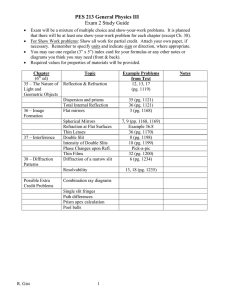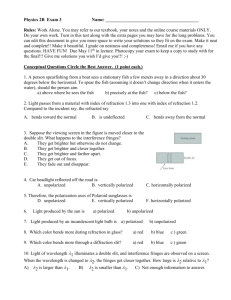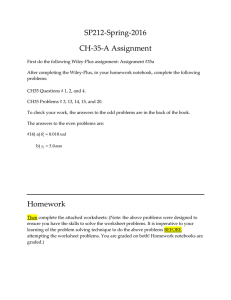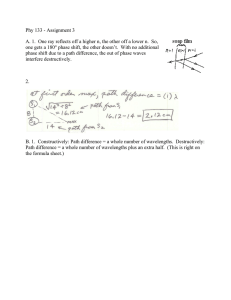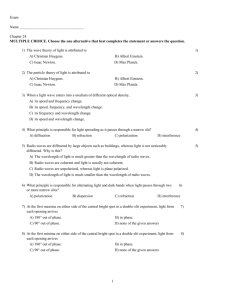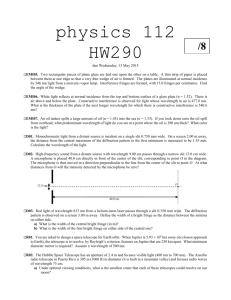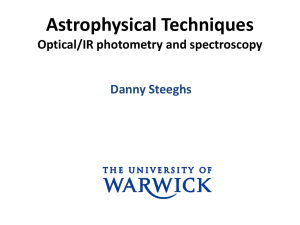Spectroscopy techniques II Danny Steeghs
advertisement
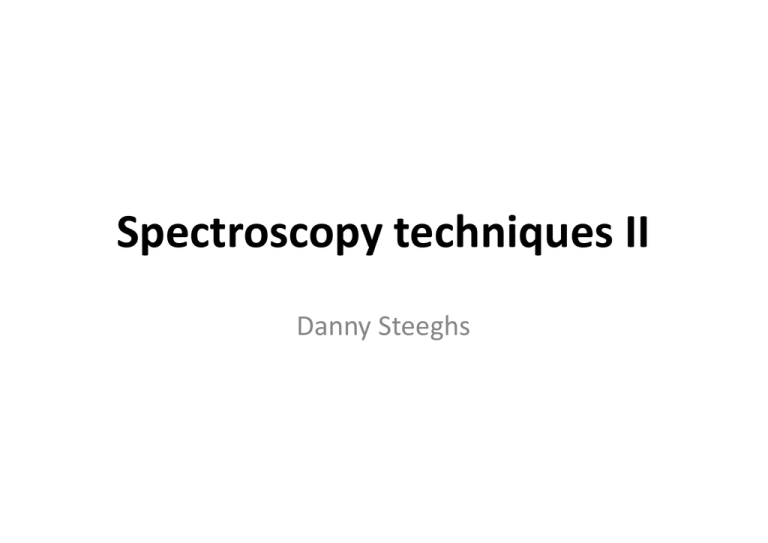
Spectroscopy techniques II Danny Steeghs Conducting long-slit spectroscopy • Science goals must come first, what are the resolution and S/N requirements? Is there a restriction on exposure time? Decide on the best compromise between these constraints, you will soon enough run out of photons • Identify a slit-width/disperser combination that provides the required dispersion and sampling – Seeing or slit-width limited? • Work out calibrations required – Always try to take cal data through same/similar lightpath Slit-filling effects • A slit-limited setup ensures that the slit is always illuminated uniformly [provided the object is centered] • A partially illuminated slit (because image quality is better than the slit-width) may introduce shifts in the projected spectrum as different areas of the slit are illuminated as a function of time • This will lead to shifts in both the spatial and dispersion direction of the spectrum when comparing to calibration data that are obtained with a fully illuminated slit • Not good if you are after accurate radial velocities! Atmospheric dispersion • Differential atmospheric refraction will deflect a source by an amount that is dependent on wavelength [the index of refraction is a function of wavelength] • A point source position on the sky is dependent on wavelength! • The displacement is towards the zenith and larger for shorter wavelengths • This obviously affects acquisition and slit-angle strategies when obtaining spectroscopy Atmospheric dispersion • Index of refraction: n(l,T,p,f) wavelength, temperature, pressure, water vapor • Angle displacement: DR = R(l1)- R(l2) Dn(Dl) tan z zenith angle (airmass) • Some example shifts (“) relative to image at 5000Å : airmass 3000Å 4000Å 6000Å 10000Å 1.00 0.00 0.00 0.00 0.00 1.25 1.59 0.48 -0.25 -0.61 2.00 3.67 1.10 -0.58 -1.40 Atmospheric dispersion • Make sure you acquire the target at a wavelength relevant for your spectral range [TV filter] d • • • Differential refraction will mean differential slit-losses’: can only centre object at one l If the slit is vertical (relative to horizon/zenith line), differential refraction will occur purely along the slit This means that the slit P.A. (sky angle) must change with time. The vertical P.A. is the parallactic angle zenith R.A. zenith Extracting the spectrum signal = (source + background) – background@source S(l) = S I(y,l) p(y) – S I(y,l) b(y) object profile weight sky profile weight y l Detector corrections ; BIAS & FLAT • CCD corrections need to be performed first • BIAS/DARK can be treated in the same way as for imaging – – – – Determine importance of dark current Use a large median stack of bias frames Master-bias versus overscan Measure readout-noise Detector corrections ; BIAS Detector corrections ; FLAT • Flat-fielding is probably one of the trickier steps – Uniform illumination along the slit – Uniform illumination along the dispersion direction • Need a light source with a smooth/simple spectrum spectrum of a Tungsten lamp Detector corrections ; FLAT • The trick is to remove the spectrum of the calibration lamp and normalise the flatfield – Not always possible to distinguish between broad CCD sensitivity features and features in the lamp fit corrected flat normalised raw flat Detector corrections ; FLAT Detector corrections ; FLAT crap on the slit pixel-to-pixel sensitivity fringes Watch for gradients/structure along the slit, may need a twilight flat (useless in the spectral direction) to correct spatial profile make sure slit width, grating angle, filters are all in place, replicating as much the light path to the science frames Locating the object and sky Object 1 Object 2 Sky 1 Sky 2 Tracing and skyfit sky regions object regions Evaluate sky background at each wavelength by considering the sky pixels around the shifting object [if you are lucky, sky lines are well-aligned with the CCD columns] This gives you the fitted background value at the location of the object Net signal ; naive method S(l) = S ( I(y,l) – sky(y,l) ) unweighted sum over object region skyfit at each object pos Optimal extraction • Optimal sum across the object profile considers the fractional contribution of a given pixel to the total light at that wavelength and weighs its contribution p(y) • Optimal weights (minimising variance) : w(y) p(y) / s(y)2 [see stats lectures] • p(y) is measured from the 2D frame and normalised such that S p(y) = 1 when summed along the extraction region y Optimal extraction • Need to estimate s(y) reliably from readout noise and gain such that Poisson noise and background subtraction errors are properly propagated • Not only provides the optimal sum with a significant S/N improvement in the extracted spectrum, but also allows the easy flagging of outlier pixels due to cosmic rays or CCD defect Calibrating ; from x to l Calibrating ; from x to l • Emission line lamps are used for translating CCD pixel coordinates to wavelengths (e.g. Ar, He, Ne, Cu) • These arc exposures are extracted using the same profile weights as for the object to ensure any tilt/rotation is the same • Reference line lists are used to identify line wavelengths • The line positions are fitted with a (polynomial) function to retrieve the dispersion relation l=f(x) • Regular arcs need to be obtained since flexure in the telescope/spectrograph system causes drifts as a function of time and position of the telescope • Typically the resultant wavelength scale should be good to a fraction of a pixel (can measure the centroid of a spectral feature to very high precision given sufficient S/N, well below the spectral resolution) Calibrating : from counts to flux known fluxes • Spectro-photometric standard stars (flux standards) have measured fluxes as a function of wavelength across specified band-passes • Observe flux star with a wide slit at low airmass to ensure all flux is collected • Response function corrects detected counts into flux units Diff. spectrophotometry • Flux calibration is still subject to variable slit-losses since target observations are observed through a narrow slit • A second reference star can be aligned to fall along the slit such that both target and reference star spectra can be extracted • A differential flux correction can then be made by comparing the narrow slit observations with a wide slit observation of the reference star • This requires the slit-angle to be fixed, and thus not be at the parallactic angle! ‘Final’ product • • • • Air/vacuum wavelengths Velocity rest-frame ; geocentric frame Extinction/telluric correction Now the fun can begin : velocities, abundances etc. Some pit-falls • Know your noise – readout noise + Poisson noise + background noise + systematics • Regimes – readout noise limited at low S/N – background limited at longer wavelengths • Nodding/shuffling • Calibration data – Take darks, biases, flats, arcs etc. in all setups – Standard stars Distortions Some example stellar spectra Some example stellar spectra Quasar


